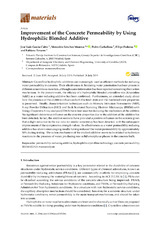Mostrar el registro sencillo del ítem
Improvement of the Concrete Permeability by Using Hydrophilic Blended Additive
| dc.contributor.author | García Calvo, José Luis | |
| dc.contributor.author | Sánchez Moreno, Mercedes | |
| dc.contributor.author | Carballosa, Pedro | |
| dc.contributor.author | Pedrosa, Filipe | |
| dc.contributor.author | Tavares, Fabiano | |
| dc.date.accessioned | 2019-07-26T10:30:26Z | |
| dc.date.available | 2019-07-26T10:30:26Z | |
| dc.date.issued | 2019 | |
| dc.identifier.uri | http://hdl.handle.net/10396/18925 | |
| dc.description.abstract | Crystalline hydrophilic additives are increasingly used as efficient methods for reducing water permeability in concrete. Their effectiveness in hindering water penetration has been proven in different cementitious materials, although scarce information has been reported concerning their action mechanism. In the present work, the efficacy of a hydrophilic blended crystalline mix (Krystaline Add1) as a water-reducing additive has been confirmed. Furthermore, an extended study about how the presence of the additive influences both the fresh state and the hardened state properties is presented. Finally, characterization techniques such as Mercury Intrusion Porosimetry (MIP), X-ray Powder Diffraction (XRD) and Back-Scattered Scanning Electron Microscopy (BSEM) with Energy Dispersive X-ray analysis (EDAX) have been used for deducing the mechanism of the additive. No significant deleterious influence on the concrete properties due to the addition of the additive has been detected. In fact, the additive seems to have provided a positive influence on the concrete given that a slight reduction in the w/c ratio for similar consistency has been detected, with the subsequent improvement of the compressive strength values. Its effectiveness as a water permeability reducing additive has shown encouraging results having reduced the water permeability by approximately 50% during testing. The action mechanism of the studied additive seems to be related to hydration reactions in the presence of water, producing new solid amorphous phases in the concrete bulk. | es_ES |
| dc.format.mimetype | application/pdf | es_ES |
| dc.language.iso | eng | es_ES |
| dc.publisher | MDPI | es_ES |
| dc.rights | https://creativecommons.org/licenses/by/4.0/ | es_ES |
| dc.source | Materials 12(15), 2384 (2019) | es_ES |
| dc.subject | Permeability-reducing additive | es_ES |
| dc.subject | Hydrophilic crystalline technology | es_ES |
| dc.subject | Concrete permeability | es_ES |
| dc.subject | BSEM-EDAX microanalysis | es_ES |
| dc.title | Improvement of the Concrete Permeability by Using Hydrophilic Blended Additive | es_ES |
| dc.type | info:eu-repo/semantics/article | es_ES |
| dc.relation.publisherversion | http://dx.doi.org/10.3390/ma12152384 | es_ES |
| dc.relation.projectID | Gobierno de España. BIA2015-64363-R | es_ES |
| dc.relation.projectID | Gobierno de España. RYC-2016-21422 | es_ES |
| dc.relation.projectID | Unión Europea. COST Action CA15202 | es_ES |
| dc.rights.accessRights | info:eu-repo/semantics/openAccess | es_ES |

